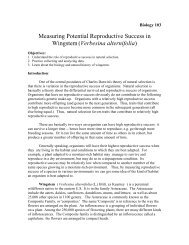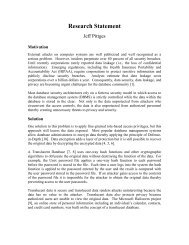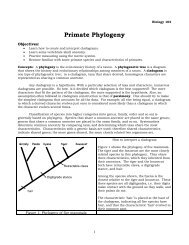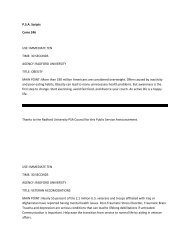History Of Typography - Radford University
History Of Typography - Radford University
History Of Typography - Radford University
You also want an ePaper? Increase the reach of your titles
YUMPU automatically turns print PDFs into web optimized ePapers that Google loves.
and the great French typographer Geofroy Tory, who studied<br />
the composition of letters according to the proportions of the<br />
human body in the Champfleury (1529), a treatise on type<br />
design.<br />
An important event which encouraged a new approach to<br />
printing was the sack of Mainz in 1462, which forced many<br />
of Gutenberg’s collaborators to leave the town. They took<br />
the secrets of printing to several European countries. Around<br />
1470 one of them, the French engraver Nicolas Jenson settled<br />
in Venice, where he drew inspiration from humanist scripts in<br />
designing a new type with wedge-shaped serifs. This pure and<br />
beautiful style was known as roman, a name which would in<br />
future be applied to typefaces with an upright design. Among<br />
the heirs to his workshop in that illustrious city was the<br />
learned Aldus Manutius, one of the great figures in European<br />
publishing. His type designer, Francesco Griffo of Bologna,<br />
cut the first example of a sloping type which became known as<br />
Aldine and is today called italic. It was based on the informal<br />
cursive writing developed by chancery clerks to speed their<br />
work.<br />
The sixteenth century was the Golden Age of calligraphy<br />
in Europe, rich in great calligraphers such as Ludovico degli<br />
Arrighi, Ugo da Carpi, Giovanniantonio Tagliente and Palatino<br />
in Italy, Jean Beauchenne in France and Roger Ascham in<br />
England. As progress was made in copper engraving, so a<br />
cursive script with slender finials (terminal hooks) emerged<br />
and came to fruition in the work of Lucas Matherot and Louis<br />
Barbedor.<br />
In France, where the development of printing was<br />
influenced by the work of Geofroy Tory, the Estienne family<br />
was prominent. One of its members, Robert Estienne, was<br />
printer to King Francois I. He entrusted Claude<br />
Garamond with a royal command to cut typefaces for<br />
editions of classical Greek texts. The famous Grecs du Roi<br />
which resulted were uncluttered and elegant. Garamond, the<br />
first commercial typefounder, also designed the roman and<br />
italic typefaces which bear his name and which played a<br />
leading role in European typographical design until the end of<br />
the sixteenth century.<br />
In this great humanist movement, Christophe Plantin , a<br />
French bookbinder who became a citizen of Antwerp and a<br />
printer, acted as a connecting link with the Netherlands, where<br />
a great dynasty of printers, the Elzeviers, had come to the fore<br />
and would be active until the beginning of the eighteenth<br />
century. The Elzeviers gave their name to an elegant wedgeserif<br />
typeface.<br />
In 1692, during the reign of Louis XIV and classicism,<br />
Abbe Nicolas Jaugeon of the French Academy of Sciences<br />
was given the task of creating a new typeface. His design, cut<br />
by Philippe Grandjean, was called Romain du Roi and was<br />
reserved for the exclusive use of the Imprimerie Royale--the<br />
Royal Press. This cold, majestic script was first used in 1702.<br />
The eighteenth century was an age of elegant typography in<br />
Britain. The typefounder William Caslon cut a highly legible<br />
typeface which is still in use today. Caslon was the typeface<br />
in which a Baltimore printer issued the official copies of the<br />
United States Declaration of Independence. Another English<br />
printer, John Baskerville, who taught calligraphy, designed a<br />
graceful, balanced typeface which revolutionized typography<br />
and is still popular.<br />
In eighteenth-century France, Louis-Rene Luce, engraver<br />
to King Louis XV, introduced the rational spirit of the<br />
Enlightenment and the Encyclopedists into typographical<br />
experimentation, while Pierre-Simon Fournier and Francois-<br />
Ambroise Didot invented the point system of typographic<br />
measurement. Both Didot’s son Firmin and Giambattista<br />
Bodoni of Parma were inspired by Baskerville’s work to<br />
create very similar forms of austere lettering with strongly<br />
contrasting thick and thin strokes. Their work influenced<br />
nineteenth-century type design in several countries.<br />
The development of lithography, a process of printing<br />
from a stone surface invented in 1796 by the dramatist Aloys<br />
Senefelder (see page 7), encouraged printing from types based<br />
on calligraphic script with fine, supple curves. From 1830<br />
onwards, as a result of scientific and technical advances and<br />
the development of industry and trade, a dynamic form of<br />
typography came into being through the work of typefounders<br />
such as Alexandre de Berny and Theophile Beaudoire.<br />
Egyptian, with its slab serifs, and Fat Face, still widely used in<br />
the press and advertising, were highly fashionable typefaces.<br />
William Morris, the poet and writer who made a major<br />
contribution to the revival of English decorative art in<br />
the late nineteenth century, was the leader of the Arts and<br />
Crafts Movement which took inspiration from the styles of<br />
medieval times. The work produced by his Kelmscott Press<br />
had a strongly individual graphic personality and exercised<br />
wide influence. In France, George Auriol and the painter<br />
and engraver Eugene Grasset were among the masters of Art<br />
Nouveau. The latter received support from the typefounder<br />
Georges Peignot, who later, with his son Charles, produced<br />
a range of typefaces which would dominate printing until the<br />
advent of phototypesetting in 1956. Peignot, designed by the<br />
French poster artist Adolphe Mouron Cassandre in 1937, and<br />
Bifur, a shaded script of great originality, are among the finest<br />
typefaces cut by the Deberny and Peignot typefoundry.<br />
Today, although computerization is widespread, there is a<br />
welcome revival of interest among young people in the art of<br />
calligraphy, which is encouraging the search for and creation<br />
of new designs. Outstanding modern designers of digitized<br />
letters include the great German calligrapher Hermann<br />
Zapf; Adrian Frutiger of Switzerland; Ladislas Mandel, Jose<br />
Mendoza, Albert Boton, all of France; as well as the young<br />
French designer of Arin, Franck Jalleau.<br />
We are at the dawn of a new age of typography. Lettering<br />
is no longer created by lead objects but by strokes of light.<br />
Photocomposition systems can now provide higher screen<br />
resolution, allowing sharper definition of characters, as well<br />
as an immense variety of typefaces, offering great scope<br />
for creativity. Soon, these machines will achieve a degree<br />
of sensitivity close to that of handwriting, and will give<br />
typographers a degree of control over the design of lettering<br />
far superior to that of early electronic typesetting systems. But<br />
to safeguard an entire heritage of craftsmanship, metal type<br />
must not be allowed to disappear.
















